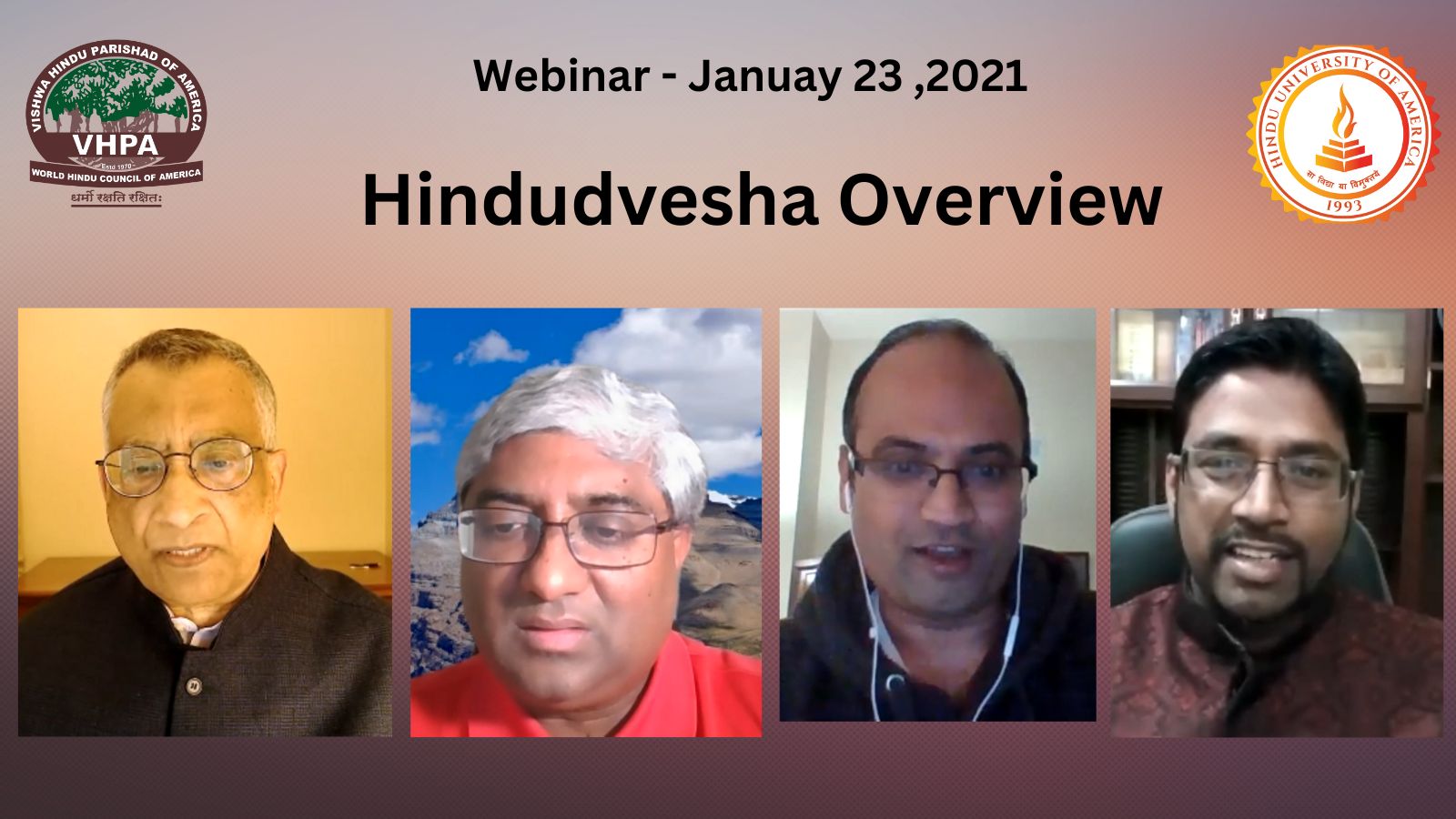

Hindudvesha Overview – Definition and Sources (Webinar)
In contemporary discourse, where the narrative is shaped by various forces and ideologies, it is crucial to recognize the presence of “Hindudvesha.” This term, a convergence of the Sanskrit “Dvesha” and the Greek “phobia,” encapsulates the deep-seated aversion and fear directed towards Hindus and Hinduism. This essay aims to elucidate the concept of Hindudvesha, its historical roots, and its systemic implications. We will examine the origins of this phenomenon in colonial discourse, the impact it has on Western academia, and its manifestations in the digital age through organizations like Equality Labs. By exploring these facets, we can gain a comprehensive understanding of the issue and its significance.
Historical Roots of Hindudvesha
To comprehend Hindudvesha, it is essential to delve into its historical origins. During the colonial era, the British colonizers, who held significant power in India, constructed a narrative that portrayed themselves as emancipators and civilizers. This narrative painted a picture of India as a civilization in need of European intervention and redemption. This colonial discourse laid the foundation for what we now identify as Hindudvesha.
The two primary sources of Hindudvesha during this period can be traced back to Christian theology and the principles of enlightened modernity. Christian theology viewed Hinduism as a pagan religion in need of salvation from its perceived devilish and satanic beliefs. The enlightened modernity perspective considered Hinduism as backward and primitive, necessitating reform and transformation. While these two sources of Hindudvesha differ in their motivations, they ultimately converge in their assessment of Hindus and Hinduism.
Hindudvesha operates on two levels: blatant and blind integration. Blatant integration involves conscious and explicit efforts to secularize, Westernize, Anglicize, modernize, or even subject Hindus to proselytization. This often leads to feelings of shame, embarrassment, and constant defensiveness among Hindus. Blind integration, on the other hand, is unconscious and implicit, assuming that Hindus need saving or reforming before they can be considered legitimate.
The legitimacy of Hindu people, their right to practice their faith, and the place of Hindu traditions and culture in contemporary society are all questioned by Hindudvesha. Blatant integration often denies its legitimacy, while blind integration may consider it with stringent oversight. Moreover, Hindudvesha raises doubts about whether Hinduism has contributed anything valuable to the world, with blatant integration dismissing such contributions and blind integration offering limited acknowledgment.
Western Academia
Western academia, a domain traditionally associated with rigorous intellectual discourse and objective pursuit of knowledge, has not remained immune to the biases of Hindudvesha. During the colonial period, influential figures in Western academia, such as James Mill, Max Müller, and Oldenburg, propagated derogatory views of Hindus. Mill characterized Hindus as dissembling and treacherous, while Max Müller suggested that Hinduism was doomed without Christian intervention. Oldenburg made derogatory comments about Hindu gods.
Unfortunately, these biased portrayals of Hindus continue in contemporary academia. Renowned Indologists, such as Wendy Doniger, have made controversial statements about revered Hindu figures. For example, Wendy Doniger implied that Lord Rama harbored nightmares of Sita’s unchastity, and Jeffrey Kripal accused Ramakrishna of being a child molester. These unfounded and offensive claims reflect the persisting biases against Hinduism in academia.
Hindudvesha in the Digital Age: The Role of Equality Labs
In the digital age, organizations like Equality Labs play a significant role in perpetuating Hindudvesha. Equality Labs ostensibly portrays itself as a champion of social justice, but it operates with a focus on fostering animosity, especially against Hindu Americans.
Equality Labs employs several methods to propagate its narrative of hate. These methods include the production of propaganda materials, hate-oriented artwork, and leveraging social media. The organization’s 2018 ‘caste report’ is a prime example of propaganda material that falsely portrays the caste system as an integral part of Hindu scripture and makes inflammatory allegations against Hindu culture, religion, and society. The hate-oriented artwork strategically uses language that implies violence, such as the word “Smash.” Equality Labs also leverages social media to influence government bodies and social media platforms, furthering their hateful agenda.
Media: Demeaning, Calls for Extermination, and Debasing Deities
Within the digital realm, Hindudvesha extends to social media, where it manifests in three forms. First, there is the demeaning and insulting of Hindu society and religion, where high-profile media personalities equate Hinduism with derogatory practices. Secondly, there are explicit calls for the extermination of Hindus via genocide, with individuals receiving awards and recognition for such hate speech. Lastly, Hindu deities are debased through vulgar depictions and descriptions, degrading sacred figures.
These portrayals employ symbolism to create hateful stereotypes against Hindus, negatively impacting their self-perception and the perception of their customs and practices.
News Media
Hindudvesha is observed in news media through both overt and covert means, perpetuating negative stereotypes and biases. The media often uses subtle techniques with plausible deniability to convey these biases. For instance, the New York Times cartoons employ caricatures that may not be obvious symbols of hate but carry underlying messages. Similarly, the representation of political figures like Narendra Modi and Recep Tayyip Erdogan in Time Magazine showcases how media can influence public perception based on the subject’s religion and cultural background.
Moving deeper into the core of Hindu Dharma and religion, the bias becomes more evident. A stark example is the differential portrayal of Abu Bakr al Baghdadi, the ISIS leader, as an “austere religious caller,” compared to Yogi Ji, the Chief Minister of Uttar Pradesh, being labeled a “militant monk.” Despite Yogi Ji’s educational qualifications and democratic leadership, the media’s portrayal reflects a clear bias.
The documentary series “Believer,” produced by Reza Aslan, is another illustration of Hindudvesha. While focusing on Hinduism, it depicts obscure cults and emphasizes controversial aspects, portraying Hindu Dharma negatively. Aslan’s acknowledgment that he deliberately sought out a certain view of Hinduism to evoke specific feelings among the audience exemplifies the media’s role in perpetuating bias.
One of the most explicit forms of Hindudvesha is observed when the media discusses Hindu festivals. In recent years, there has been a recurring pattern of misrepresenting Hindu festivals while portraying those of other religions more favorably. For example, Diwali is referred to as a “festival of fats,” while Christmas is celebrated with more positive language. The portrayal of Jallikattu and Diwali as cruel practices against animals, compared to rituals involving animal sacrifice in other cultures, highlights the media’s bias.
Holi, a popular Hindu festival, has also been subject to attempts at appropriation and distortion by various anti-Hindu groups. The media’s role in shaping public perception and making it acceptable to hold negative attitudes toward Hindu Dharma, culture, and people is evident through these representations.
Challenges and the Way Forward
Challenging Hindudvesha poses several obstacles. Hindus have often remained silent in the face of such prejudice, striving to maintain a reputation as “the good guys.” However, greater awareness, dialogue, and active participation within the community are essential to combat these challenges effectively. By understanding the historical roots of Hindudvesha, recognizing its presence in academia, and acknowledging its manifestations in the digital age through organizations like Equality Labs, we can take the first steps toward addressing and dismantling this systemic issue.
In conclusion, the concept of Hindudvesha is a multifaceted and deeply rooted phenomenon that has persisted through history and evolved in the digital age. By shedding light on its origins, manifestations, and implications, we can work towards a more inclusive and unbiased portrayal of Hindus and Hinduism in contemporary discourse.


